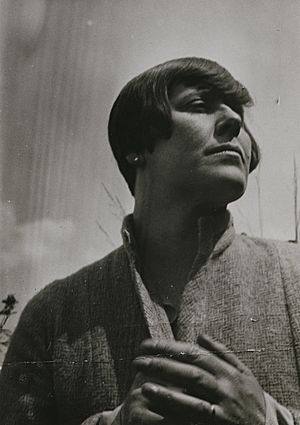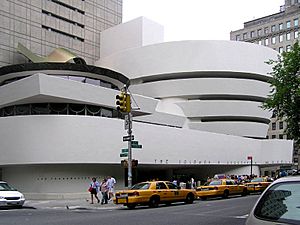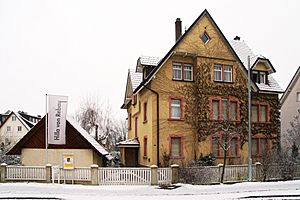Hilla von Rebay facts for kids
Quick facts for kids
Hilla Rebay
|
|
|---|---|

Hilla von Rebay in 1924, by László Moholy-Nagy
|
|
| Born |
Hildegard Anna Augusta Elisabeth Rebay von Ehrenwiesen
31 May 1890 Strasbourg, Alsace-Lorraine, German Empire
|
| Died | 27 September 1967 (aged 77) Greens Farms, Connecticut, United States
|
| Resting place | Teningen, Germany |
| Nationality | German |
| Occupation | Artist, museum director |
| Employer | Solomon R. Guggenheim Museum |
| Successor | James Johnson Sweeney |
| Parent(s) | Baron Franz Josef Rebay von Ehrenwiesen Antonie von Eicken |
Hilla Rebay (born May 31, 1890 – died September 27, 1967) was an important abstract artist in the early 1900s. She helped create and became the first director of the famous Solomon R. Guggenheim Museum in New York City. Hilla Rebay was key in helping Solomon R. Guggenheim collect "non-objective art." This type of art doesn't show real-world objects but uses shapes, colors, and lines to express ideas or feelings. This collection later became the basis for the Guggenheim Museum. She also played a big part in choosing Frank Lloyd Wright to design the museum building, which is now a well-known modern building in New York City.
Early Life and Art Studies
Hilla von Rebay grew up in a noble German family in Strasbourg, which was part of the German Empire at the time. She was the second child of Baron Franz Josef Rebay von Ehrenwiesen, who was an officer in the Prussian Army, and his wife, Antonie von Eicken.
Hilla showed a talent for art from a young age. She studied at the Cologne Kunstgewerbeschule (a school for applied arts) in 1908-1909. Then, from 1909 to 1910, she went to the Académie Julian in Paris. There, she learned traditional painting styles like landscapes and portraits. Her skills in portrait painting helped her earn money before she started focusing on abstract art.
In 1910, Rebay moved to Munich, Germany, where she lived until 1911. Here, she became more interested in modern art. In 1912, she had her first art exhibition at the Cologne Kunstverein (art association).
In 1913, Rebay's art was shown in Paris alongside famous artists like Alexander Archipenko, Constantin Brâncuși, Marc Chagall, and Diego Rivera. However, this experience made Rebay feel that her own work wasn't good enough.
In 1915, Rebay met Jean Arp in Zurich. This meeting greatly changed Rebay's artistic ideas. Through Arp, she learned about "non-objective" modern art by artists like Wassily Kandinsky, Paul Klee, and Rudolf Bauer. Around this time, she also connected with Herwarth Walden and the modern art gallery Galerie Der Sturm in Berlin. In 1920, she, Bauer, and Otto Nebel started an artist group called Der Krater.
Building the Guggenheim Museum
In January 1927, Hilla Rebay moved to the United States and settled in New York City. She was a passionate art collector. She became a close friend and advisor to Solomon R. Guggenheim, who was also a big art collector. She especially encouraged him to buy "non-objective art" by artists like Rudolf Bauer and Wassily Kandinsky.
These art purchases later became the start of the Solomon R. Guggenheim Foundation's Museum of Non-Objective Painting. This museum first opened in 1939 in a showroom in New York City. Its first exhibition, called Art of Tomorrow, opened on June 1, 1939. Rebay was the director of this museum until 1952.
In June 1943, Rebay wrote to the famous architect Frank Lloyd Wright. She asked him to design a special "museum-temple" to hold the growing art collection. While the new museum was being designed, the Museum of Non-Objective Painting moved to a townhouse on Fifth Avenue. This was the planned location for the new building. Rebay continued to organize art shows there.
The construction for the new museum finally began in 1956. The art collection was temporarily moved to another townhouse. The new museum officially opened on October 21, 1959, and was named the Solomon R. Guggenheim Museum.
Hilla Rebay was known for her excellent taste in modern art. She continued to paint and gained some recognition for her own abstract artworks. After Solomon Guggenheim passed away in 1949, she was removed from the museum's board of directors.
When the Guggenheim Museum was finished, Hilla Rebay was not invited to the opening. She never visited the museum she helped create. Feeling sad about this, Rebay stepped away from public life. She spent her last years at her home in Westport, Connecticut. She passed away in 1967 and was buried in her family grave in Teningen, Germany, as she had wished.
Hilla Rebay's Legacy
After Hilla Rebay's death in 1967, a part of her large personal art collection was given to the Solomon R. Guggenheim Museum. This is known as the Hilla Rebay Collection. It includes artworks by artists like Wassily Kandinsky, Paul Klee, and Kurt Schwitters.
In 2012, a Hilla von Rebay Association was started in Teningen, Germany. This group works to remember Rebay and her art. They run a museum in her parents' house, which Rebay had given to the town after her parents died.
- In 2004, a German documentary film called The Guggenheim and the Baroness: The Story of Hilla Rebay was made about her life.
- In 2005, a book was published about her called Die Baroness und das Guggenheim Hilla von Rebay – Eine Deutsche Künstlerin in New York.
- Also in 2005, the Guggenheim Museum honored Rebay with a special exhibition. It was called Art of Tomorrow: Hilla Rebay and Solomon R. Guggenheim. This show highlighted her important role in starting the museum and her art collection.
- The Hilla von Rebay Foundation was created in her name at the Guggenheim Museum. Its goal is to support "non-objective art."
- The Hilla Rebay International Fellowship started in 2001. It gives art students a chance to work at the Guggenheim Museums in New York, Bilbao, and Venice.
- In 2014, Rebay was a character in a play called Bauer. This play was about the life of artist Rudolf Bauer and his connection with Rebay.
- In 2017, some of Rebay's own artworks were shown at the Solomon R. Guggenheim Museum in New York. This was part of an exhibition called "Visionaries: Creating a Modern Guggenheim."




